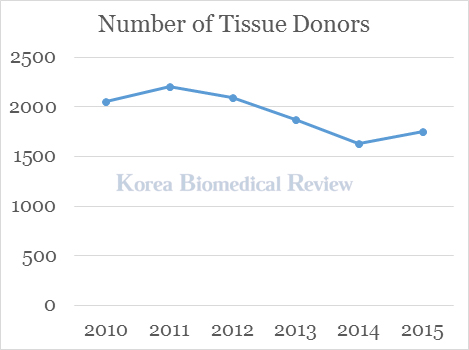Out of all tissue donations in Korea, only 26 percent are domestically procured, highlighting an import-dependent nation and a culture that is wary, or ignorant, of tissue donations, medical experts here say.
Tissue donation, much like organ donation, is the process wherein individuals agree to donate a part of their body for use in transplants to living people who need tissue replacement due to injury or genetic illness. These operations can save an individual’s life who may have lost mobility, failing or lost eyesight, or otherwise suffer from fatal injuries.
Although many deem it a noble act, the number of tissue donations in Korea remains extraordinarily low. In comparison with other countries, including the United States, Spain, France, and Australia, Korea ranked last in tissue donation per million people, according to the Ministry of Food and Drug Safety (MFDS). If the U.S. has 100 tissue donors per million people, Spain has 59, France has 30, Australia has 20, and Korea has 4.7 people.

The number of donations has also fallen since 2010 before rising incrementally in 2015. Korea is also heavily dependent on imports of human tissue grafts, with imports accounting for 73.7 percent of all human tissue donated domestically, the ministry said.
Experts point to the ignorance of the subject, lack of a culture that fosters organ or tissue donations, and a lack of funds to promote and improve the sector.
A ministry official calls for the necessity of raising private donations through promotion and emulating foreign countries.
“More than 70 percent of the donated tissue we use are imported. We need to work on promoting tissue donations in Korea,” said Moon Eun-hee, senior deputy director of the Pharmaceutical Division at the MFDS, during the Global Bio Conference held at COEX in southern Seoul Thursday. “We look into how tissue donation is facilitated in other countries, such as the U.S., which is the largest source of import. We will also work toward improving safety controls for human tissues.”

To become a tissue donor, one can contact the Korea Foundation for Human Tissue Donation (KFTD). One may expect to sign consent forms and go through a series of medical examinations for eligibility. In the event of his or her death, the tissue donor’s body will be transferred to one of KFTD’s four tissue banks and returned to the family upon completing the donation.
As for which part of the body can be donated, corneas, the middle ear, skin, heart valves, bone, veins, cartilage, tendons, and ligaments can all be donated to be stored in tissue banks. In Korea, bone tissue accounted for 75.78 percent of all donations, followed by skin (16.26 percent), tendon (4.56 percent), cartilage (1.55 percent), amniotic membrane (1.56 percent) and others at 0.28 percent.

